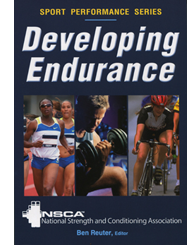Womens Health Movements a Global Force for Change Review
The following is an exclusive extract from the bookDeveloping Endurance, published by Homo Kinetics. All text and images provided by Human Kinetics.

Movement Analysis and Biomechanics
Endurance sports are typically not thought of every bit highly technical endeavors (dissimilar sports such as golf, baseball, and tennis), but proper movement during training and contest for endurance sports can affect both performance and health. The study of biomechanics refers to analyzing human move with regard to physics, kinematics, and mechanics.
Near endurance sport movements are repeated hundreds or thousands of times each training session. Therefore, proper mechanics are critical to an endurance athlete's ability to optimize performance and avoid injury. Movement evaluation can be performed using a well-trained eye, video capture, a figurer, or specialized biomechanics equipment—such as pressure sensors, force plates, and three-dimensional figurer motion analysis programs (Figure two.1).

Every endurance athlete has a unique physical build as well every bit strengths, weaknesses, and asymmetries that will dictate personal motion style; however, within each sport, some full general movement patterns are more effective and are considered proper form. For example, during running, the foot should land nearly underneath the knee to reduce braking movement on each step and to reduce the stress placed on the musculoskeletal system.
When cycling, the knee and human foot should travel in a vertical path, overlapping i another when viewed from the forepart. This reduces stress on the human knee. When pond, proper mechanics will let the athlete to move through the water more easily by producing less elevate and will also reduce strain on the shoulder articulation.
Coaches and athletes tin can learn to clarify movement past viewing performances of the proper grade and mechanics within their sport. They can do this in person or by reviewing video. Keep in mind that the top athletes in a given sport do non always apply optimal biomechanics and may exist successful despite their technique. Variations from one athlete to another are normal, simply coaches should be able to evaluate an athlete'south biomechanics and advise drills and corrections that will assist the athlete improve. Coaches often utilize video to record their athletes' techniques.
Video analysis can be used to slow the body movements to a speed that allows viewers to discern small details that the unaided centre might not run into. Coaches should review the video with their athletes to reinforce constructive movement patterns and point out areas for improvement.
Athletes who practice non have a personal charabanc can do much of this evaluation by themselves or with the help of a partner who tin run the video camera or digital camera. Free or low-price video assay programs ofttimes come standard on a computer. However, more technical software packages such every bit Dartfish technology allow for more comprehensive video analysis (including synchronizing multiple camera views, drawing angles, and adding comments or written text on videos).
More sophisticated equipment such every bit pressure sensors and three-dimensional imaging systems may be available at specialized sports medicine facilities, medical facilities, universities, and other inquiry institutions. These tools can be used by biomechanists and specially trained clinical staff to take a closer look at the movements an athlete is making.
Many endurance athletes and coaches overlook the apply of biomechanical assay as a tool for helping to alter or improve an athlete's current mechanics. The typical thinking is that endurance athletes move the way that they naturally do and should merely improve their fettle without worrying almost poor mechanics. Although the differences in improved mechanics can be subtle, they are very constructive in reducing injury and improving performance.
Movement analysis tin too aid determine the types of sport-specific and supplemental training, such as resistance training, that tin improve performance. Proper analysis should include evaluation of the bodily muscle groups being used (prime movers and stabilizers), the blazon of muscle action occurring (concentric, eccentric, isometric, or a combination of these), the velocity of contraction and movement, the range of movement of the joints, and the type of energy organisation used to deliver energy (immediate, curt-term, or long-term energy system). All of these factors should exist known before prescribing training and exercises meant to improve an private's capability and performance.

Figure ii.2 presents a worksheet that athletes can utilise to perform their ain movement assay. An athlete should complete this class periodically to monitor motility changes and adaptations that can occur with regular training. The best strategy is to complete the class every 4 to 8 weeks after completing similar workouts. The form is subjective and can be used for any sport or activity, but it works all-time for those activities that are repetitive—such as running, biking, and swimming.
From the National Strength and Conditioning Association (NSCA) comes this resource packed with more than 100 drills to assist in the evolution of agility and quickness training programs. Applicative to nearly every sport, Developing Agility and Quickness focuses on improving athletes' fleetness of pes, change-of-management speed, and reaction time. The book is available in bookstores everywhere, besides as online in the NSCA Store.
Source: https://www.nsca.com/education/articles/kinetic-select/movement-analysis-and-biomechanics-for-endurance-sports/
0 Response to "Womens Health Movements a Global Force for Change Review"
Enregistrer un commentaire